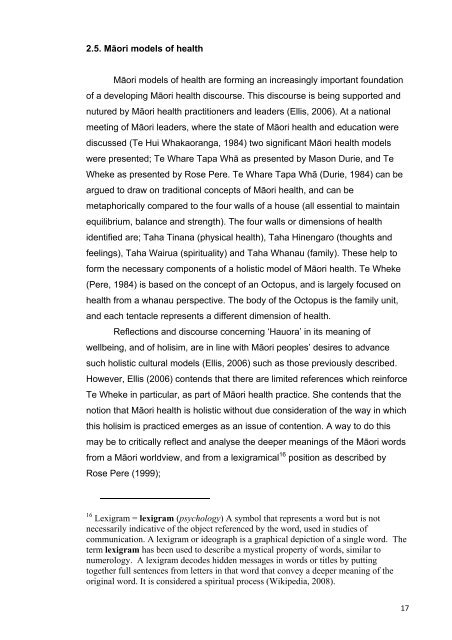Te Māoritanga WELLBEING AND IDENTITY Kapa Haka as a Vehicle
Te Māoritanga WELLBEING AND IDENTITY Kapa Haka as a Vehicle
Te Māoritanga WELLBEING AND IDENTITY Kapa Haka as a Vehicle
You also want an ePaper? Increase the reach of your titles
YUMPU automatically turns print PDFs into web optimized ePapers that Google loves.
2.5. Māori models of health<br />
Māori models of health are forming an incre<strong>as</strong>ingly important foundation<br />
of a developing Māori health discourse. This discourse is being supported and<br />
nutured by Māori health practitioners and leaders (Ellis, 2006). At a national<br />
meeting of Māori leaders, where the state of Māori health and education were<br />
discussed (<strong>Te</strong> Hui Whakaoranga, 1984) two significant Māori health models<br />
were presented; <strong>Te</strong> Whare Tapa Whā <strong>as</strong> presented by M<strong>as</strong>on Durie, and <strong>Te</strong><br />
Wheke <strong>as</strong> presented by Rose Pere. <strong>Te</strong> Whare Tapa Whā (Durie, 1984) can be<br />
argued to draw on traditional concepts of Māori health, and can be<br />
metaphorically compared to the four walls of a house (all essential to maintain<br />
equilibrium, balance and strength). The four walls or dimensions of health<br />
identified are; Taha Tinana (physical health), Taha Hinengaro (thoughts and<br />
feelings), Taha Wairua (spirituality) and Taha Whanau (family). These help to<br />
form the necessary components of a holistic model of Māori health. <strong>Te</strong> Wheke<br />
(Pere, 1984) is b<strong>as</strong>ed on the concept of an Octopus, and is largely focused on<br />
health from a whanau perspective. The body of the Octopus is the family unit,<br />
and each tentacle represents a different dimension of health.<br />
Reflections and discourse concerning ‘Hauora’ in its meaning of<br />
wellbeing, and of holisim, are in line with Māori peoples’ desires to advance<br />
such holistic cultural models (Ellis, 2006) such <strong>as</strong> those previously described.<br />
However, Ellis (2006) contends that there are limited references which reinforce<br />
<strong>Te</strong> Wheke in particular, <strong>as</strong> part of Māori health practice. She contends that the<br />
notion that Māori health is holistic without due consideration of the way in which<br />
this holisim is practiced emerges <strong>as</strong> an issue of contention. A way to do this<br />
may be to critically reflect and analyse the deeper meanings of the Māori words<br />
from a Māori worldview, and from a lexigramical 16 position <strong>as</strong> described by<br />
Rose Pere (1999);<br />
16 Lexigram = lexigram (psychology) A symbol that represents a word but is not<br />
necessarily indicative of the object referenced by the word, used in studies of<br />
communication. A lexigram or ideograph is a graphical depiction of a single word. The<br />
term lexigram h<strong>as</strong> been used to describe a mystical property of words, similar to<br />
numerology. A lexigram decodes hidden messages in words or titles by putting<br />
together full sentences from letters in that word that convey a deeper meaning of the<br />
original word. It is considered a spiritual process (Wikipedia, 2008).<br />
17
















